...loading...
Introduction to jacktrip
23 June, 2020
Chris Chafe and friends, CCRMA Stanford University
Doable: - small groups playing together between home locations (say < 12 members)
- concert broadcast via Youtube Live, Vimeo, Zoom
- linux, mac, windows, BSD laptops and desktops (also Raspberry Pi)
- own choice of audio interfaces with mics, etc.
Doable: - small groups playing together between home locations (say < 12 members)
- concert broadcast via Youtube Live, Vimeo, Zoom
- linux, mac, windows, BSD laptops and desktops (also Raspberry Pi)
- own choice of audio interfaces with mics, etc.
Difficult: - larger groups (but we haven't tried)
- wifi (requires ethernet wire from home router)
- built-in sound on laptops
Difficult: - larger groups (but we haven't tried)
- wifi (requires ethernet wire from home router)
- built-in sound on laptops
Impossible: - syncronized video (but try LOLA for that)
- conducted ensembles
- mobile devices
- hosted wine and cheese receptions
Impossible: - syncronized video (but try LOLA for that)
- conducted ensembles
- mobile devices
- hosted wine and cheese receptions
Plan for this evening: - terminology
- live demo
- building groups
- home stations
- Q&A
- hands-on
Plan for this evening: - terminology
- live demo
- building groups
- home stations
- Q&A
- hands-on
latency is the time delay between cause and effect -- used interchangeably
an internet host is a computer on the network -- used interchangeably
a server listens for a client to connect to it -- different jacktrip modes
each jacktrip instance runs a transmitter and receiver -- bidirectional
my local host and a remote peer host -- either can run in either jacktrip mode
our IETF -- owes everything to ietf.org
latency is the time delay between cause and effect -- used interchangeably
an internet host is a computer on the network -- used interchangeably
a server listens for a client to connect to it -- different jacktrip modes
each jacktrip instance runs a transmitter and receiver -- bidirectional
my local host and a remote peer host -- either can run in either jacktrip mode
our IETF -- owes everything to ietf.org
Audio quality: - buffer size (affects latency)
- gain
- feedback
- number of channels
- self-monitoring
- muting other audio applications (Zoom)
- sharing audio signal between applications (audacity)
- running Zoom on a second host (mobile or laptop)
Audio quality: - buffer size (affects latency)
- gain
- feedback
- number of channels
- self-monitoring
- muting other audio applications (Zoom)
- sharing audio signal between applications (audacity)
- running Zoom on a second host (mobile or laptop)
Network quality: - physical distance and number of intermediate router hops in path (affects latency)
- playback queue (affects latency)
- jitter vs. packet loss
- redundancy for forward error correction
- wavetable vs. zeroes (very "backwards" error concealment)
- better error concealment (under construction)
- network peering locations can be a surprise
- last mile (fiber, cable, vdsl, microwave, 5G)
- wifi inadequate but useful for basic testing
- choke points, competing applications on the same local host and local network, internet weather
- venues, when we get to use them again
Network quality: - physical distance and number of intermediate router hops in path (affects latency)
- playback queue (affects latency)
- jitter vs. packet loss
- redundancy for forward error correction
- wavetable vs. zeroes (very "backwards" error concealment)
- better error concealment (under construction)
- network peering locations can be a surprise
- last mile (fiber, cable, vdsl, microwave, 5G)
- wifi inadequate but useful for basic testing
- choke points, competing applications on the same local host and local network, internet weather
- venues, when we get to use them again
violin and cello demo
acoustic instruments with air mics
Alex Goldberg and Marina Bosi, Redwood City
talkback channel, in this case it's Zoom
violin and cello demo
acoustic instruments with air mics
Alex Goldberg and Marina Bosi, Redwood City
talkback channel, in this case it's Zoom
 simple two-way (aka, full-duplex) stereo connection
simple two-way (aka, full-duplex) stereo connection
(-s / -c)
 hub mode
hub mode
(-S / -C)
 Cristina's comparisons, a) acoustic room b) hub mode network
Cristina's comparisons, a) acoustic room b) hub mode network
c) labyrinths d) shortest path network
when the "atoms" combine in a hub server, they can be connected in different ways
use -p to patch them together into a "molecule"
 4=full mix
4=full mix
(everyone hears everyone but not the server itself)
 2=client fan out/in but not loopback
2=client fan out/in but not loopback
 1=client loopback
1=client loopback
 0=server-to-clients
0=server-to-clients
153b groups during this past Spring Quarter - jazz sextet+
- new music Bay Area
- Stanford new music ensemble
- new music quartets (JACK, Kronos)
- wind quintet
- 153b jam band
153b groups during this past Spring Quarter - jazz sextet+
- new music Bay Area
- Stanford new music ensemble
- new music quartets (JACK, Kronos)
- wind quintet
- 153b jam band
the paths forward for local ensembles
equip musicians with their choice of devices
set up local servers - DIY software installs (like we know)
- nearby hardware-based servers (like we know)
- Raspberry Pi + soundcard (plug+play with interface)
- nearby cloud servers
- ...and DIY Raspberry Pi systems (mouse, keyboard, monitor)
all open source
Raspberry Pi solutions and cloud-based services are in the works and will be obtainable from third parties
the paths forward for local ensembles
equip musicians with their choice of devices
set up local servers - DIY software installs (like we know)
- nearby hardware-based servers (like we know)
- Raspberry Pi + soundcard (plug+play with interface)
- nearby cloud servers
- ...and DIY Raspberry Pi systems (mouse, keyboard, monitor)
all open source
Raspberry Pi solutions and cloud-based services are in the works and will be obtainable from third parties
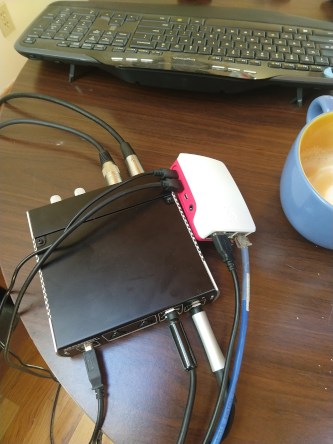 Raspberry Pi 4 + Presonus soundcard (audio interface)
Raspberry Pi 4 + Presonus soundcard (audio interface)
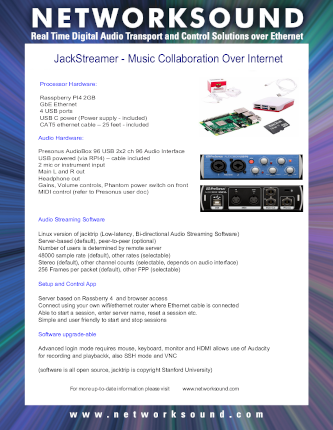 available ($349)
available ($349)
example videos
QoS measurements
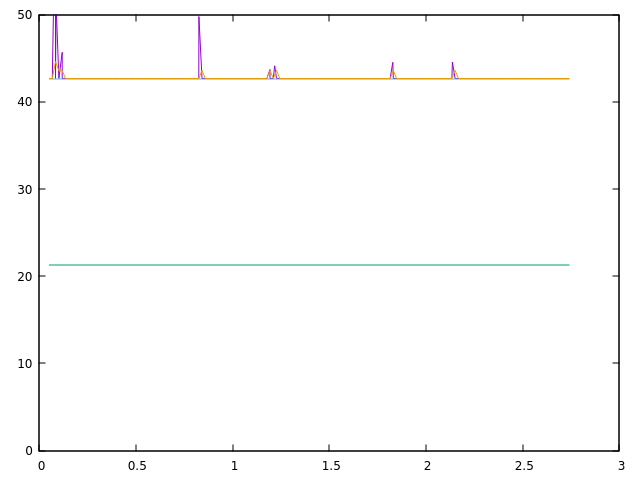 chris WIFI / 12Mb cable
chris WIFI / 12Mb cable
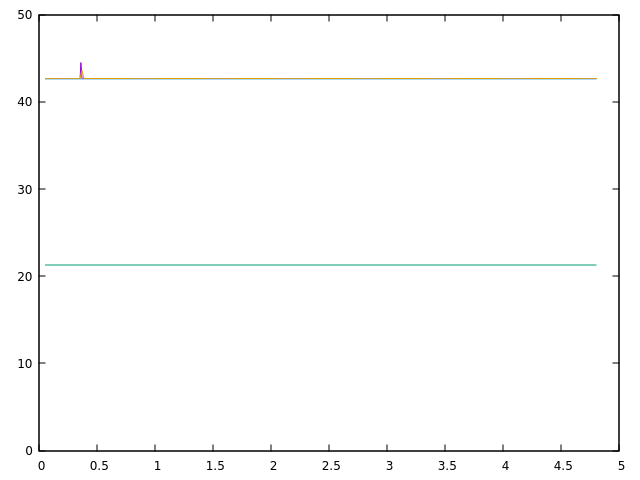 chris ethernet wired / 12Mb cable
chris ethernet wired / 12Mb cable
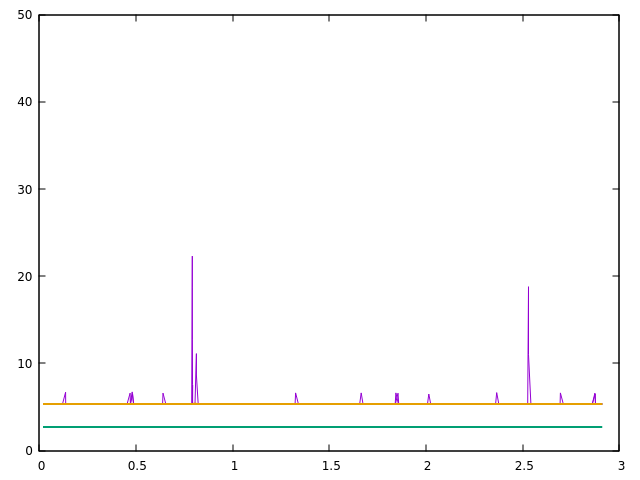 sarah / 1Gb fiber
sarah / 1Gb fiber
 sarah / 200Mb? cable
sarah / 200Mb? cable
 combinations of -q settings at FPP = 32
combinations of -q settings at FPP = 32
free online course for background (mostly videos)
see CCRMA's web page, under Research : Software : jacktrip for installation guides
The one-quarter course meets online twice a week: Mondays and Fridays at 2:30pm for 50 minutes. The Zoom URL will be emailed to participants ahead of each meeting.
Sign-up: students should enroll in Music 153b, auditors are welcome and can join by contacting Chris Chafe
Listserv: emails will go out to ietf@ccrma.stanford.edu
Sign-up: students should enroll in Music 153b, auditors are welcome and can join by contacting Chris Chafe
Listserv: emails will go out to ietf@ccrma.stanford.edu
Previous course:
Online Jamming, TU Berlin, Winter 2019-2020
Upcoming course in Stanford sequence:
Music 153a Online Jamming and Concert Technology, Autumn 2020-2021
Online Jamming, TU Berlin, Winter 2019-2020
Upcoming course in Stanford sequence:
Music 153a Online Jamming and Concert Technology, Autumn 2020-2021
Monday, April 6 - introduction
- installation
- test machine: 171.64.197.160
- settings:
srate = 48kHz, buffer size = 1024, channels = 1 - command:
./jacktrip -C 171.64.197.160 -n1
Monday, April 6 - introduction
- installation
- test machine: 171.64.197.160
- settings:
srate = 48kHz, buffer size = 1024, channels = 1 - command:
./jacktrip -C 171.64.197.160 -n1
srate = 48kHz, buffer size = 1024, channels = 1 ./jacktrip -C 171.64.197.160 -n1
Session 2
April 10 -- group connections
admin stuff
for ugrad & grad students: zero-unit enrollment -- is possible
read this
let me know via an email you'd like to enroll for zero units because I need to file a request
ping -- the ping utility is turned off (by policy) for all CCRMA servers
I'll let you know if that changes
gear
USB mic works great
qjackctl can be configured to independently choose a USB mic as the input device and a separate output device
Blue Yeti USB mic can be both (it has a headphone jack)
group connections
Before going on the network, do an audio test first: - start qjackctl
- in the connection window, connect mic to speakers or headphones
- verify that there is signal
- tap directly on the mic to be sure it's the right mic (not a built-in laptop mic)
- click on disconnect
- verify that the signal goes away (otherwise it's not qjackctl that's created the connection and most likely it's a direct sound monitoring path in your sound card)
Before going on the network, do an audio test first: - start qjackctl
- in the connection window, connect mic to speakers or headphones
- verify that there is signal
- tap directly on the mic to be sure it's the right mic (not a built-in laptop mic)
- click on disconnect
- verify that the signal goes away (otherwise it's not qjackctl that's created the connection and most likely it's a direct sound monitoring path in your sound card)
Which jacktrip mode to run: - simple peer-to-peer server
./jacktrip -s - simple peer-to-peer client
./jacktrip -c <IP Address or Name of server> - hub (group) server
./jacktrip -S - client of hub (group) server
./jacktrip -C <IP Address of server>
(-C mode doesn't recognize name, yet)
Which jacktrip mode to run: - simple peer-to-peer server
./jacktrip -s - simple peer-to-peer client
./jacktrip -c <IP Address or Name of server> - hub (group) server
./jacktrip -S - client of hub (group) server
./jacktrip -C <IP Address of server>
(-C mode doesn't recognize name, yet)
./jacktrip -s ./jacktrip -c <IP Address or Name of server> ./jacktrip -S ./jacktrip -C <IP Address of server>
(-C mode doesn't recognize name, yet)
Connect to jacktrip loopback server: - command:
./jacktrip -C 171.64.197.160 -n1 - play or sing a sustained tone
- listen for dropouts
- watch for "waited too long" messages
- too many dropouts?
- increase the input queue by adding -q<N>, for example, a queue of 8 packets (default = 4)
- command with queue of 8 packets:
./jacktrip -C 171.64.197.160 -n1 -q8
Connect to jacktrip loopback server: - command:
./jacktrip -C 171.64.197.160 -n1 - play or sing a sustained tone
- listen for dropouts
- watch for "waited too long" messages
- too many dropouts?
- increase the input queue by adding -q<N>, for example, a queue of 8 packets (default = 4)
- command with queue of 8 packets:
./jacktrip -C 171.64.197.160 -n1 -q8
./jacktrip -C 171.64.197.160 -n1 ./jacktrip -C 171.64.197.160 -n1 -q8
Things that prevent connection - mismatch between local and peer sample rate
--restart qjackctl with same sample rate as peer - mismatch between local and peer buffer size
--restart qjackctl with same buffer size as peer, also called frames / period - "waiting for peer" forever
usually this is because computer firewall or router firewall is blocking incoming data
Things that prevent connection - mismatch between local and peer sample rate
--restart qjackctl with same sample rate as peer - mismatch between local and peer buffer size
--restart qjackctl with same buffer size as peer, also called frames / period - "waiting for peer" forever
usually this is because computer firewall or router firewall is blocking incoming data
--restart qjackctl with same sample rate as peer
--restart qjackctl with same buffer size as peer, also called frames / period
usually this is because computer firewall or router firewall is blocking incoming data
Matt's explanation of the all those "jacks".
jackd is the actual Jack (jack audio connection kit process -- a daemon)
The "d" stands for daemon
It runs in the background letting other programs on the computer send and receive audio to each other and to whatever audio hardware jack is connected to.
jackd can be started from the command line but is more often launched from JackPilot or qjackctl
JackPilot is a graphical front-end to Jack.
It’s a program that opens a window you can click on, has a "Preferences" window, etc.
JackPilot’s preferences window is where you can:
- select which audio interface you want Jack to use
- select the Sample Rate and Buffer Size that Jack will use
- configure JackRouter
You must set all such preferences before starting Jack.
You can start Jack by clicking "Start" in the main JackPilot window. (On OSX this is the recommended way to start Jack)
On OSX with a normal Jack installation, the JackPilot program lives in
/Applications/Jack, that is, the "Jack" subfolder of the main Applications folder.
Matt's explanation of the all those "jacks".
jackd is the actual Jack (jack audio connection kit process -- a daemon)
The "d" stands for daemon
It runs in the background letting other programs on the computer send and receive audio to each other and to whatever audio hardware jack is connected to.
jackd can be started from the command line but is more often launched from JackPilot or qjackctl
JackPilot is a graphical front-end to Jack.
It’s a program that opens a window you can click on, has a "Preferences" window, etc.
JackPilot’s preferences window is where you can:
- select which audio interface you want Jack to use
- select the Sample Rate and Buffer Size that Jack will use
- configure JackRouter
You must set all such preferences before starting Jack.
You can start Jack by clicking "Start" in the main JackPilot window. (On OSX this is the recommended way to start Jack)
On OSX with a normal Jack installation, the JackPilot program lives in
/Applications/Jack, that is, the "Jack" subfolder of the main Applications folder.
Matt's explanation (cont'd)
qjackctl is another graphical front-end to Jack.
"qjackctl" is pronounced "cue jack control" (though Mark Applebaum suggests making it rhyme with "pterodactyl") Its main window is (confusingly) titled "JACK Audio Connection Kit"
On OSX with a normal Jack installation, the qjackctl program lives in
/Applications/Jack, that is, the "Jack" subfolder of the main Applications folder.
The yellow word at the center top of the window will be "Active" if (qjackctl understands that) jack is running, or "Inactive" or "Stopped" otherwise
Please ignore all the green writing (which has to do with MIDI, not audio)
The "preferences" for qjackctl are in the "Setup" window, which you open and close by clicking the "Setup…" button on the main window
The most useful part of qjackctl is the "Connections" window, which you open and close by clicking the "Connect" button on the main window
The connections window shows all the jack-enabled programs currently running through Jack. It lets you connect any output of any program to any input of any program.
On OSX it appears that you cannot start Jack from qjackctl. JackRouter is part of Jack on OSX that lets non-jack-enabled programs (for example iTunes, QuickTime Player, Chrome) connect their audio to Jack.
Matt's explanation (cont'd)
qjackctl is another graphical front-end to Jack.
"qjackctl" is pronounced "cue jack control" (though Mark Applebaum suggests making it rhyme with "pterodactyl") Its main window is (confusingly) titled "JACK Audio Connection Kit"
On OSX with a normal Jack installation, the qjackctl program lives in
/Applications/Jack, that is, the "Jack" subfolder of the main Applications folder.
The yellow word at the center top of the window will be "Active" if (qjackctl understands that) jack is running, or "Inactive" or "Stopped" otherwise
Please ignore all the green writing (which has to do with MIDI, not audio)
The "preferences" for qjackctl are in the "Setup" window, which you open and close by clicking the "Setup…" button on the main window
The most useful part of qjackctl is the "Connections" window, which you open and close by clicking the "Connect" button on the main window
The connections window shows all the jack-enabled programs currently running through Jack. It lets you connect any output of any program to any input of any program.
On OSX it appears that you cannot start Jack from qjackctl. JackRouter is part of Jack on OSX that lets non-jack-enabled programs (for example iTunes, QuickTime Player, Chrome) connect their audio to Jack.
Session 3
April 13 -- dialing into the sweet spot
admin stuff
the 1-unit course limit can't be changed, use 220d to add 2-4 more units as desired and let me know
I'm editing and streaming the class video recordings from CCRMA.
I've had requests for a commercial streaming service so I simply added links to the raw video on Zoom. These include the chat transcript which isn't anonymous. If that's problematic please let me know after this session.
minimizing delay
maximizing audio quality
maximizing network quality (as much as possible, given best effort network protocols)
latency is the time delay between cause and effect -- used interchangeably
an internet host is a computer on the network -- used interchangeably
a server listens for a client to connect to it -- different jacktrip modes
each jacktrip instance runs a transmitter and receiver -- bidirectional
my local host and a remote peer host -- either can run in either jacktrip mode
our IETF -- owes everything to ietf.org
latency is the time delay between cause and effect -- used interchangeably
an internet host is a computer on the network -- used interchangeably
a server listens for a client to connect to it -- different jacktrip modes
each jacktrip instance runs a transmitter and receiver -- bidirectional
my local host and a remote peer host -- either can run in either jacktrip mode
our IETF -- owes everything to ietf.org
Audio quality: - buffer size (affects latency)
- gain
- feedback
- number of channels
- self-monitoring
- muting other audio applications (Zoom)
- sharing audio signal between applications (audacity)
- running Zoom on a second host (mobile or laptop)
Audio quality: - buffer size (affects latency)
- gain
- feedback
- number of channels
- self-monitoring
- muting other audio applications (Zoom)
- sharing audio signal between applications (audacity)
- running Zoom on a second host (mobile or laptop)
Network quality: - physical distance and number of intermediate router hops in path (affects latency)
- playback queue (affects latency)
- jitter vs. packet loss
- redundancy for forward error correction
- wavetable vs. zeroes (very "backwards" error concealment)
- better error concealment (under construction)
- network peering locations can be a surprise
- last mile (fiber, cable, vdsl, microwave, 5G)
- wifi inadequate but useful for basic testing
- choke points, competing applications on the same local host and local network, internet weather
- venues, when we get to use them again
Network quality: - physical distance and number of intermediate router hops in path (affects latency)
- playback queue (affects latency)
- jitter vs. packet loss
- redundancy for forward error correction
- wavetable vs. zeroes (very "backwards" error concealment)
- better error concealment (under construction)
- network peering locations can be a surprise
- last mile (fiber, cable, vdsl, microwave, 5G)
- wifi inadequate but useful for basic testing
- choke points, competing applications on the same local host and local network, internet weather
- venues, when we get to use them again
cello demo
acoustic cello with air mic
electric cello
talkback channel, in this case it's Zoom
cello demo
acoustic cello with air mic
electric cello
talkback channel, in this case it's Zoom
breakout rooms here we go again, 5 this time
171.64.197.160
171.64.197.169
171.64.197.156
171.64.197.166
171.64.197.207
breakout rooms here we go again, 5 this time
171.64.197.160
171.64.197.169
171.64.197.156
171.64.197.166
171.64.197.207
adopt-a-server
public IP address for ensemble members to connect to
start jackd from command line and jacktrip server in loopback (or other audio patch) mode
use tmux to be able to detach job and leave it running 24/7
basic manual operation
(no watchdog process or email alerts from server)
adopt-a-server
public IP address for ensemble members to connect to
start jackd from command line and jacktrip server in loopback (or other audio patch) mode
use tmux to be able to detach job and leave it running 24/7
basic manual operation
(no watchdog process or email alerts from server)
CCRMA machines are available
CCRMA account required to login to CCRMA machines
CCRMA machines are available
CCRMA account required to login to CCRMA machines
Ensemble info : - which instruments in the ensemble
- audio equipment needed
- computers needed
- which operating systems will be used
- (email to cc@ccrma.stanford.edu)
Ensemble info : - which instruments in the ensemble
- audio equipment needed
- computers needed
- which operating systems will be used
- (email to cc@ccrma.stanford.edu)
Session 4
April 17 -- server side operation
jacktrip molecules and atoms
molecules:
we've been practicing hub mode (-S / -C)
which is made out of multiple atoms:
simple two-way, connections (-s / -c)
jacktrip molecules and atoms
molecules:
we've been practicing hub mode (-S / -C)
which is made out of multiple atoms:
simple two-way, connections (-s / -c)
Ensemble sound checks - get the group talking together on Zoom, jitsi, skype or the like
- have each member test their local audio loopback:
qjackctl connect capture -> playback - tech lead person start group server in full mix mode:
./jacktrip -S -p4 - have each member test their network audio:
./jacktrip -C <server_IP_address> -n1 - when everyone can hear everyone else well, end the connections
- tech lead person restart group server in FOFI mode:
./jacktrip -S -p2 - then everyone rejoin and take it from there
Ensemble sound checks - get the group talking together on Zoom, jitsi, skype or the like
- have each member test their local audio loopback:
qjackctl connect capture -> playback - tech lead person start group server in full mix mode:
./jacktrip -S -p4 - have each member test their network audio:
./jacktrip -C <server_IP_address> -n1 - when everyone can hear everyone else well, end the connections
- tech lead person restart group server in FOFI mode:
./jacktrip -S -p2 - then everyone rejoin and take it from there
qjackctl connect capture -> playback
./jacktrip -S -p4 ./jacktrip -C <server_IP_address> -n1 ./jacktrip -S -p2
Monday, 19th (open forum using jacktrip audio
I'll pipe in some historical examples)
work with a group from now - Thursday and give us a report
next lecture session on Friday, 24th, 2:30pm
(how to get software updates,
how to run simple two-way connections and server-less operation,
utilities: ping, traceroute, iperf)
Server stress test - test your local audio loopback:
qjackctl connect capture -> playback - test your network with loopback server:
./jacktrip -C 171.64.197.160 -n1 - join the horde, crash the server:
./jacktrip -C 171.64.197.158 -n1
Server stress test - test your local audio loopback:
qjackctl connect capture -> playback - test your network with loopback server:
./jacktrip -C 171.64.197.160 -n1 - join the horde, crash the server:
./jacktrip -C 171.64.197.158 -n1
qjackctl connect capture -> playback
./jacktrip -C 171.64.197.160 -n1 ./jacktrip -C 171.64.197.158 -n1
Session 6
April 24 -- simple two-way setup
We've been using hub mode (a fancy conference call) which depends on relaying all signals via a hub server. Simple two-way connections are direct between two peers and don't require a hub server.
jacktrip two-way, bidirectional audio connection - server and client
- start jack audio on both sides
- start the server first
- server:
./jacktrip -s -n1 - client:
./jacktrip -c <server_IP_address> -n1 - or:
./jacktrip -c <server_host_name> -n1
jacktrip two-way, bidirectional audio connection - server and client
- start jack audio on both sides
- start the server first
- server:
./jacktrip -s -n1 - client:
./jacktrip -c <server_IP_address> -n1 - or:
./jacktrip -c <server_host_name> -n1
./jacktrip -s -n1 ./jacktrip -c <server_IP_address> -n1 ./jacktrip -c <server_host_name> -n1
server must have port open - incoming UDP port 4464 (is default)
- select a different port with "-o" port offset
- server:
./jacktrip -s -n1 -o10 (uses UDP port 4474) - client:
./jacktrip -c <server_IP_address> -n1 -o10
server must have port open - incoming UDP port 4464 (is default)
- select a different port with "-o" port offset
- server:
./jacktrip -s -n1 -o10 (uses UDP port 4474) - client:
./jacktrip -c <server_IP_address> -n1 -o10
./jacktrip -s -n1 -o10 (uses UDP port 4474) ./jacktrip -c <server_IP_address> -n1 -o10useful debugging utilities: ping, traceroute, iperf
ping -
ping www.yahoo.com -
ping 171.64.197.1 - might not respond (dead or wrong name, wrong IP address)
- might not want to respond (policy reasons, for example no CCRMA machines will answer)
ping -
ping www.yahoo.com -
ping 171.64.197.1 - might not respond (dead or wrong name, wrong IP address)
- might not want to respond (policy reasons, for example no CCRMA machines will answer)
ping www.yahoo.com ping 171.64.197.1
traceroute -
traceroute www.yahoo.com - shows path through intervening routers
- pinging them in succession
- prints * * * if no response
traceroute -
traceroute www.yahoo.com - shows path through intervening routers
- pinging them in succession
- prints * * * if no response
traceroute www.yahoo.com
iperf - server and client (same style as jacktrip)
- sends a test batch of data from client to server
- server:
iperf -u -s -p 4464 - client:
iperf -u -c <server_IP_address> -p 4464 - I use iperf2 but iperf3 exists
iperf - server and client (same style as jacktrip)
- sends a test batch of data from client to server
- server:
iperf -u -s -p 4464 - client:
iperf -u -c <server_IP_address> -p 4464 - I use iperf2 but iperf3 exists
iperf -u -s -p 4464 iperf -u -c <server_IP_address> -p 4464 upcoming software updates and how to get them
what I have learned in the last 3 weeks
terminology, names - jack server (audio)
- hub server (a host for hub mode)
- peer-to-peer server (starts a two-way)
terminology, names - jack server (audio)
- hub server (a host for hub mode)
- peer-to-peer server (starts a two-way)
jack operation - where settings are set
- only one jackd at a time
- use "killall jackd" command
- doesn’t have to be issued from the same directory, and should result in
"jackd: no process found" once there's no longer a jackd
jack operation - where settings are set
- only one jackd at a time
- use "killall jackd" command
- doesn’t have to be issued from the same directory, and should result in
"jackd: no process found" once there's no longer a jackd
"jackd: no process found" once there's no longer a jackd
OS installation - a file permissions bug in the current macOS installer
- unidentified developer, package cannot be opened, or installation is potential malware (Go to System Preferences / Security and Privacy)
- Windows security settings; Allow an app through firewall.
- Windows Peer to Peer Collaboration Foundation
- curious error messages that need explaining: MMCSS API not used
OS installation - a file permissions bug in the current macOS installer
- unidentified developer, package cannot be opened, or installation is potential malware (Go to System Preferences / Security and Privacy)
- Windows security settings; Allow an app through firewall.
- Windows Peer to Peer Collaboration Foundation
- curious error messages that need explaining: MMCSS API not used
server management - accidental root login will lock out their next attempts, remote CCRMA users to use their account name explicitly
- need to initiate the ssh -Y from an X server (such as XQuartz on macOS)
- audio permissions on server for remote users
- script timings vs. jack (sometimes need to add a small amount of sleep)
server management - accidental root login will lock out their next attempts, remote CCRMA users to use their account name explicitly
- need to initiate the ssh -Y from an X server (such as XQuartz on macOS)
- audio permissions on server for remote users
- script timings vs. jack (sometimes need to add a small amount of sleep)
versions
jacktrip versions (-v) -- should be latest, V1.2 qjackctl changed and there are two versions running "Connections" is now labeled "Graph" instead but you can change it back not all dongles
versions
details that get in the way - selection of mode (particularly "-C" vs. "-c")
- audio settings on all machines must match, particularly sample rate
- running only 1 channel (using only one side of headphones)
- builtin mic / builtin speaker can squeal with loopback insanely
- using a disabled command argument, the software should print a warning (-S -n)
details that get in the way - selection of mode (particularly "-C" vs. "-c")
- audio settings on all machines must match, particularly sample rate
- running only 1 channel (using only one side of headphones)
- builtin mic / builtin speaker can squeal with loopback insanely
- using a disabled command argument, the software should print a warning (-S -n)
good surprises! - running associated audio applications can work
- there are some unexpected and working audio interfaces (USB microphones, guitar amps)
- we are in a rare position (worldwide) having a flock of physical servers to use (others are using cloud and paying)
good surprises! - running associated audio applications can work
- there are some unexpected and working audio interfaces (USB microphones, guitar amps)
- we are in a rare position (worldwide) having a flock of physical servers to use (others are using cloud and paying)
good and not a surprise! - many 153b jacktrip saints!
especially Matt, Synthia, Dave, Bonnie, Nick and all who are helping others
good and not a surprise! - many 153b jacktrip saints!
especially Matt, Synthia, Dave, Bonnie, Nick and all who are helping others
especially Matt, Synthia, Dave, Bonnie, Nick and all who are helping others
to discover through use - home ISP service can degrade
- push the limits on number of channels
- how low can you go, latency-wise
to discover through use - home ISP service can degrade
- push the limits on number of channels
- how low can you go, latency-wise
Monday's meeting, session 7 (5 enrolled students) -- entirely on jacktrip
Session 8
May 1 -- Concerts, and testing! And bigger servers!
Saturday concerts (May 2) --
(Sarah Weaver) Magnify the Sound will present a 20 minute live musical performance from 3 different locations in Norway exploring the interplay and live processing between drums/percussion and electric guitar.
10am (PDT) NowNet Arts Online Performance Series
(Constantin Basica) CCRMA Live "In the past few weeks, we have been programming, testing, and rehearsing in an online environment between California, which is facing a 'shelter-in-place' situation, Berlin (DE) with strict 'Kontakt- und Ausgangsbeschränkungen', and Ghent (BE). Each Saturday afternoon we are presenting a concert that connects six musicians from these locations and guests from other places to each other. The sessions are broadcast live with audio and video feeds from each site.
1pm (PDT) Quarantine Sessions #6
"JackTrip in Zoom (Webinar)" -- the 10am
"They are running JackTrip, routed into Zoom. Thomas was able to get into their university facilities and bring the drumset player Carl. Trond has a network arts studio he built out at home. He was able to coordinate with the local public internet provider to optimize his routing and configurations. So that's how they are running JackTrip.
They have the whole JackTrip connection in one computer, they are slightly delaying the signal in order to line it up with the Zoom video latency, adding slight reverb, and then outputting into a Zoom computer.
I have a "Webinar" room in Zoom now, so the viewer only sees the artists. The audience is listed as attendees and only communicates via the text chat. It is a different presence but it's a significant improvement to the look of the event. Still would prefer to see small visual icons of the audience on the bottom of the screen, maybe this will be a feature in the future or in a different platform that emerges.
The dress rehearsal yesterday was impressive. This is the closest I have experienced to a real "virtual venue". It's much better sound with JackTrip and the "Webinar" room looks good. Adding the slight delay to JackTrip lines up the visuals. This felt exciting. "
"JackTrip in Zoom (Webinar)" -- the 10am
"They are running JackTrip, routed into Zoom. Thomas was able to get into their university facilities and bring the drumset player Carl. Trond has a network arts studio he built out at home. He was able to coordinate with the local public internet provider to optimize his routing and configurations. So that's how they are running JackTrip.
They have the whole JackTrip connection in one computer, they are slightly delaying the signal in order to line it up with the Zoom video latency, adding slight reverb, and then outputting into a Zoom computer.
I have a "Webinar" room in Zoom now, so the viewer only sees the artists. The audience is listed as attendees and only communicates via the text chat. It is a different presence but it's a significant improvement to the look of the event. Still would prefer to see small visual icons of the audience on the bottom of the screen, maybe this will be a feature in the future or in a different platform that emerges.
The dress rehearsal yesterday was impressive. This is the closest I have experienced to a real "virtual venue". It's much better sound with JackTrip and the "Webinar" room looks good. Adding the slight delay to JackTrip lines up the visuals. This felt exciting. "
"jacktrip in Youtube and Vimeo Live" -- the 1pm
The 'Quarantine Sessions' are realized using free and open source technologies, which can be easily adopted by anyone:
jacktrip (audio) jitsi (video) OBS (streaming)
"jacktrip in Youtube and Vimeo Live" -- the 1pm
The 'Quarantine Sessions' are realized using free and open source technologies, which can be easily adopted by anyone:
jacktrip (audio) jitsi (video) OBS (streaming)
network fiber laces the world
watch this now
Inside the Beach House
network fiber laces the world
watch this now
Inside the Beach House
153b concert? For end-of-term? - who's already planning something?
- bring some of the current groups to the "stage"
- form new groups
153b concert? For end-of-term? - who's already planning something?
- bring some of the current groups to the "stage"
- form new groups
ensemble query followup in our group - Mac Kenley, trombonist
- Lesley Roberston, violist
- Jerry McBride, wind quintet
ensemble query followup, new groups - Golden Gate Men's Chorus
- San Francisco Early Music Society
- Paul DeMarinis, Laetitia Sonami, Sue Costabile, event at SAIC (Chicago)
- Marie-Louise Catsalis (work with music theater students)
ensemble query followup in our group - Mac Kenley, trombonist
- Lesley Roberston, violist
- Jerry McBride, wind quintet
ensemble query followup, new groups - Golden Gate Men's Chorus
- San Francisco Early Music Society
- Paul DeMarinis, Laetitia Sonami, Sue Costabile, event at SAIC (Chicago)
- Marie-Louise Catsalis (work with music theater students)
network fiber laces the world
watch this now
Inside the Beach House
network fiber laces the world
watch this now
Inside the Beach House
new upgrade version of jacktrip - -C (connect to server by name or IP address)
- -Sz (hub mode with zeroes)
new upgrade version of jacktrip - -C (connect to server by name or IP address)
- -Sz (hub mode with zeroes)
testing it - today both cmn9.stanford.edu and
cm-jam.stanford.edu are servers running the new version - number of clients is limited to virtual cores still
testing it - today both cmn9.stanford.edu and
cm-jam.stanford.edu are servers running the new version - number of clients is limited to virtual cores still
cm-jam.stanford.edu are servers running the new version


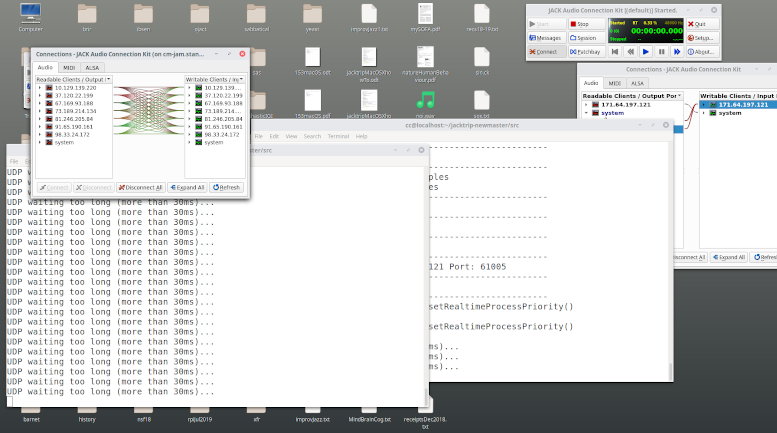


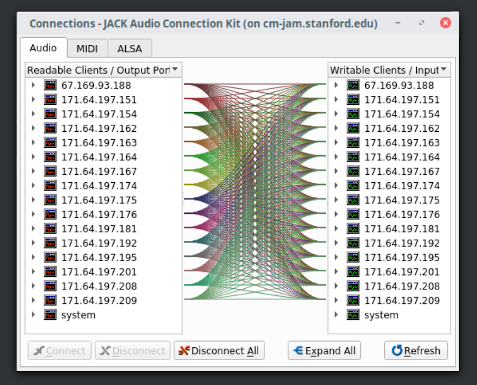
 microphone connected through a reverberator to loudspeaker
microphone connected through a reverberator to loudspeaker
 loopback with loop filter
loopback with loop filter
 1024 frames/period Jack = 42.7
1024 frames/period Jack = 42.7  512 frames/period Jack = 21.3
512 frames/period Jack = 21.3 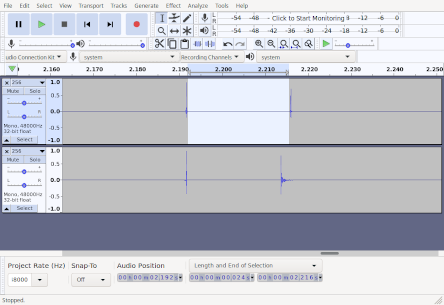 256 frames/period Jack = 10.7
256 frames/period Jack = 10.7  128 frames/period Jack = 5.33
128 frames/period Jack = 5.33  soundcard latencies measured through Jack at FPP from 16 t0 1024 (input connected to output)
soundcard latencies measured through Jack at FPP from 16 t0 1024 (input connected to output)
 combinations of -q settings at FPP = 64
combinations of -q settings at FPP = 64